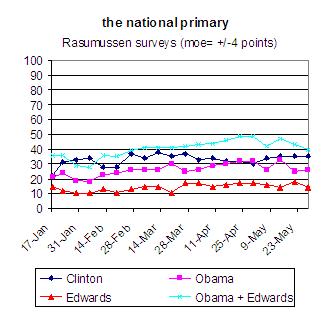I’ve been in Chicago for an interesting research conference on civic participation. There was some discussion about how empirical research should relate to “normative” thinking, i.e., arguments about how citizens ought to act, or how institutions should treat citizens. One of my colleagues* suggested that it might be helpful to provide empirical researchers with a menu of reasonable normative ideals, each of which might support different policies and outcome measures.
I’d first note that many people care about politics because they have substantive goals: for instance, social justice, individual liberty, moral reform, or concern for nature. Thus we could begin by listing substantive political ideals. But that would produce a huge array, especially once we cross-referenced each substantive goal with various ideas about appropriate political behavior. (For instance, you can be an environmentalist who believes in public deliberation, an environmentalist revolutionary, or an environmentalist who thinks that consumers and conservationists should bargain with business interests.) Thus I’d begin by conceding that there will be debates about what makes a good (or better) society. Assuming that the people engaged in these debates want to handle their differences democratically, we can turn to various rival views of democracy:
1. Theories of democratic participation
a. Equal influence in an adversarial system: The main purpose of politics is to bend institutions to one’s own purposes, nonviolently. As in the title of Harold Lasswell’s 1958 book, politics is “Who Gets What, When, How.” It is desirable that poor and marginalized people participate in politics effectively, because this is their way to counter massive inequality in the economy. Voting is a core measure of participation; votes should be numerous, and the poor should be at least as prone to vote as the rich. Other forms of political engagement are also aimed at the state or at major private institutions, e.g., persuading others to vote, protesting, and filing lawsuits. The value of a political act depends on its impact, which is empirically measurable. For example, a protest may affect the government more or less than a vote, depending on the circumstances.
b. Deliberation: The main purpose of politics is to exchange ideas and reasons so that opinions can become more fair and informed before people take action. A vote is not a good act unless it is well informed and reflects ethical judgment and learning. Participation in meetings is good, especially if the meetings include ideologically diverse people, operate according to fair rules and norms, and conclude with agreement. The use of high-quality news and opinion sources is another indicator of deliberation.
c. Public work: Citizens create public goods by working together–especially in civil society, but also in markets and within the government if these venues are reasonably fair. Public goods include cultural products, the creation of which is an essential democratic act. Relevant individual-level indicators include “working with others to address a community problem” (a standard survey question) or–specifically–participation in environmental restoration, educational projects, public art, etc. Perhaps the best indicators are not measures of individual behavior but rather assessments of “the commonwealth,” which is the sum of public goods.
d. Civic republicanism: Political participation is an intrinsically dignified, rewarding, and honorable activity, particularly superior to consumerism. It is implausible that voting once a year could be dignified and rewarding; but deliberation or public work could be.
Civic participation is not only a means to change society; it is also part of the citizen’s life. Thus we also need to consider:
2. Theories of the good life
a. Critical autonomy: The individual should be as free as possible from inherited biases and presumptions. We should hold our opinions and roles by choice and revise them according to evidence and alternative views. Not only should people choose their substantive political values, but they should decide, after due reflection, whether or not to engage politically.
b. Eudaimonism: A good life is a happy life, if happiness is properly understood. (And that’s a matter of debate.) The happiness of all human beings should matter to each of us, which implies strong and universalistic moral obligations.
c. Communitarianism: We are born into communities that profoundly shape us. Although we should have some rights of voice within our communities and exit in cases of oppression, true autonomy is a chimera and membership is a necessary source of meaning. Participation in a community is essential, but what constitutes appropriate participation is at least somewhat relative to local norms.
d. Creativity: The good life involves some measure of innovation, expression, and the creation of things that have lasting value. Creative work can be collaborative, in which case it requires civic engagement.
These two lists could be combined to create an elaborate grid or taxonomy (which would become 3-D if we added substantive political goals). I’m struck that especially my second list looks rather idiosyncratic, even though my intention was merely to summarize prevailing, mainstream views. I’m not sure what that says about me or this subject.
*I have a self-imposed policy against identifying other people who attend meetings with me.
